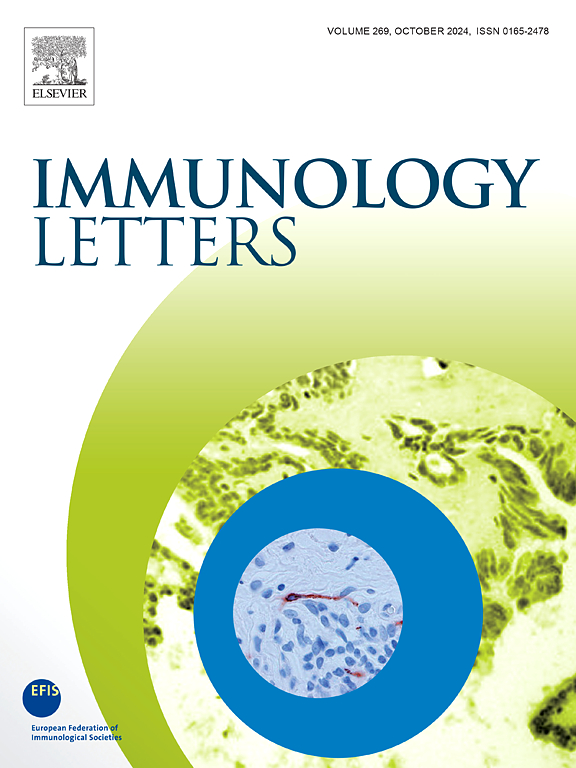急性COVID-19期间B细胞失调是短暂的。
IF 2.8
4区 医学
Q3 IMMUNOLOGY
引用次数: 0
摘要
背景:COVID-19仍是全球重大卫生问题。B细胞对COVID-19的反应已在急性重症疾病中得到广泛研究,但在长期随访或轻度疾病中较少研究。急性COVID-19期间持续的免疫变化和疱疹病毒再激活被认为是COVID-19急性后后遗症(PASC)的因素。在这里,我们评估了B细胞亚群的自然动力学,以及急性COVID-19和长期随访期间B细胞活性增加的血清学标志物。我们还测量了急性COVID-19期间人类疱疹病毒的再激活。方法:收集120例SARS-CoV-2阳性患者(门诊患者 = 56例,住院患者 = 64例)在急性疾病和恢复期(症状出现后460天,dsso)多达5个时间点的血浆和外周血单个核细胞样本。我们使用流式细胞术测定循环B细胞和Th细胞亚群,并测量游离轻链,以及来自血浆样本的eb病毒(EBV)血清学和疱疹病毒qPCR。在covid后3-12个月自我报告嗅觉缺失作为PASC的代表。结果:所有B细胞亚群比例的变化在200dsso内归一化。同样,在循环T滤泡辅助细胞和T滤泡调节细胞比例中观察到的急性改变很快稳定下来。游离轻链在急性COVID-19中较高,尤其是住院患者,但在随访期间趋于正常。EBV和人疱疹病毒6B (HHV-6B)在住院患者中的再激活率明显高于门诊患者,分别为47%和19%的住院患者和4.3%和0%的门诊患者。嗅觉缺失与疱疹病毒再激活无显著相关性。结论:在SARS-CoV-2感染期间,循环B细胞和Th细胞亚群发生了过渡性变化,但这些变化在随访中恢复。EBV和HHV-6B再激活在住院患者中很常见,但它们与持续嗅觉缺失无关。本文章由计算机程序翻译,如有差异,请以英文原文为准。
B cell dysregulation during acute COVID-19 is transient
Background
COVID-19 is still a significant health concern worldwide. B cell responses to COVID-19 have been extensively studied in acute severe disease, but less so during extended follow-up or mild disease. Persisting immunological changes together with herpesvirus reactivations during acute COVID-19 have been suggested as contributing factors for post-acute sequelae of COVID-19 (PASC). Here, we evaluated the natural kinetics of B cell subpopulations together with serological markers of increased B cell activity during acute COVID-19 and long-term follow-up. We also measured human herpesvirus reactivations during acute COVID-19.
Methods
We collected plasma and peripheral blood mononuclear cell samples from 120 SARS-CoV-2 positive patients (outpatients = 56, inpatients = 64) at up to five timepoints during acute disease and recovery (up to 460 days since symptom onset, dsso). We determined circulating B cell and Th cell subpopulations using flow cytometry, and measured free light chains, in addition to Epstein-Barr virus (EBV) serology, and herpesvirus qPCR from the plasma samples. The presence of anosmia as a proxy for PASC was self-reported at 3–12 months post-COVID.
Results
All changes in B cell subpopulation proportions normalized within 200 dsso. Likewise, the acute alterations observed in circulating T follicular helper and T follicular regulatory cell proportions stabilized soon after. Free light chains were high in acute COVID-19, especially in inpatients, but normalized during follow-up. EBV and human herpesvirus 6B (HHV-6B) reactivations were significantly more common in inpatients than outpatients, with reactivation in 47 and 19 % of inpatients and 4.3 and 0 % of outpatients respectively. Anosmia was not significantly associated with any herpesvirus reactivation.
Conclusions
The circulating B cell and Th cell subpopulations experience transitional changes during SARS-CoV-2 infection, but these changes recover in follow-up. EBV and HHV-6B reactivations are common in inpatients, but they are not associated with persisting anosmia.
求助全文
通过发布文献求助,成功后即可免费获取论文全文。
去求助
来源期刊

Immunology letters
医学-免疫学
CiteScore
7.60
自引率
0.00%
发文量
86
审稿时长
44 days
期刊介绍:
Immunology Letters provides a vehicle for the speedy publication of experimental papers, (mini)Reviews and Letters to the Editor addressing all aspects of molecular and cellular immunology. The essential criteria for publication will be clarity, experimental soundness and novelty. Results contradictory to current accepted thinking or ideas divergent from actual dogmas will be considered for publication provided that they are based on solid experimental findings.
Preference will be given to papers of immediate importance to other investigators, either by their experimental data, new ideas or new methodology. Scientific correspondence to the Editor-in-Chief related to the published papers may also be accepted provided that they are short and scientifically relevant to the papers mentioned, in order to provide a continuing forum for discussion.
 求助内容:
求助内容: 应助结果提醒方式:
应助结果提醒方式:


